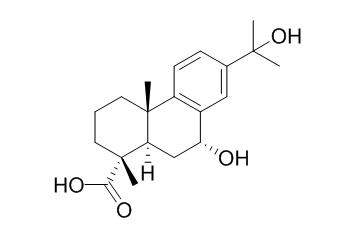7alpha,15-Dihydroxydehydroabietic acid
7alpha,15-Dihydroxydehydroabietic acid may exhibit significant cytotoxic activity.
Inquire / Order:
manager@chemfaces.com
Technical Inquiries:
service@chemfaces.com
Tel:
+86-27-84237783
Fax:
+86-27-84254680
Address:
1 Building, No. 83, CheCheng Rd., Wuhan Economic and Technological Development Zone, Wuhan, Hubei 430056, PRC
Providing storage is as stated on the product vial and the vial is kept tightly sealed, the product can be stored for up to
24 months(2-8C).
Wherever possible, you should prepare and use solutions on the same day. However, if you need to make up stock solutions in advance, we recommend that you store the solution as aliquots in tightly sealed vials at -20C. Generally, these will be useable for up to two weeks. Before use, and prior to opening the vial we recommend that you allow your product to equilibrate to room temperature for at least 1 hour.
Need more advice on solubility, usage and handling? Please email to: service@chemfaces.com
The packaging of the product may have turned upside down during transportation, resulting in the natural compounds adhering to the neck or cap of the vial. take the vial out of its packaging and gently shake to let the compounds fall to the bottom of the vial. for liquid products, centrifuge at 200-500 RPM to gather the liquid at the bottom of the vial. try to avoid loss or contamination during handling.
J Breast Cancer.2015, 18(2):112-118
Front Microbiol.2023, 14:921653.
Biomed Sci Letters.2020, 26:319-326
Chem Biol Interact.2019, 315:108910
J Nat Prod.2022, doi: 10.1021
EXCLI J.2023, 22:482-498.
Phytochemistry.2017, 141:162-170
Appl. Sci.2025, 15(1), 247
Chinese J of Tissue Engineering Res.2022, 26(17): 2636-2641.
Biosci. Rep.2020, 10.1024
Related and Featured Products
Chem Biodivers. 2017 Apr;14(4).
Pinecone of Pinus koraiensis Inducing Apoptosis in Human Lung Cancer Cells by Activating Caspase-3 and its Chemical Constituents.[Pubmed:
28027428]
Pinecones from Pinus koraiensisSiebold & Zucc. (Pinaceae), which have historically been treated as an undesired waste by-product in the processing of seeds, have recently been shown to contain ingredients with potent biological activities, such as polyphenols exhibiting antitumor activity.
METHODS AND RESULTS:
With this study, we seek to broaden our understanding of antitumor compounds contained in these pinecones beyond just polyphenols. We found that the water extract of P. koraiensis pinecones exhibits significant cytotoxic activity, with IC50 values ranging from 0.62 to 1.73 mg/ml in four human lung cancer cell lines, A549, H1264, H1299, and Calu-6, irrespective of their p53 status. We also demonstrate that pinecone water extract induces apoptosis associated with caspase-3 activation in the same cancer cell lines. Chemical investigation of the pinecone water extract revealed eight main components (1 - 8), and their structures were identified as dehydroabietic acid (1), 15-hydroxy-7-oxodehydroabietic acid (2), 7β,15-dihydroxydehydroabietic acid (3), β-d-glucopyranosyl labda-8(17,13)-diene-(15,16)-lactone-19-oate (4), 7alpha,15-Dihydroxydehydroabietic acid(5), (+)-(1S,2S,4R)-limonene-1,2-diol (6), sobrerol (7), and 4-hydroxybenzoic acid (8).
CONCLUSIONS:
These findings suggest a novel biological application of P. koraiensis pinecones in combatting human lung cancer, and further identify the major compounds that could contribute to this anticancer activity.
Fitoterapia. 2012 Jan;83(1):1-5.
Two new abietane diterpenoids from the caulis and leaves of Callicarpa kochiana.[Pubmed:
21983345]
Previous studies revealed that diterpenoids from Callicarpa genus were mainly of clerodane-type and phyllocladane-type, and abietane-type diterpenoids were seldom reported.
METHODS AND RESULTS:
In this paper, we reported two new abietane diterpenoids, kochianic acid A (1) and kochianic acid B (2), together with two known abietane-type diterpenoids, pedunculatic acid B (3) and 7alpha,15-Dihydroxydehydroabietic acid(4), which were all isolated from Callicarpa kochiana.
CONCLUSIONS:
The structures of the new compounds 1 and 2 were elucidated on the basis of extensive spectroscopic analysis, including HSQC, HMBC, (1)H-(1)H COSY, ROESY and finally confirmed by single-crystal X-ray diffraction.



